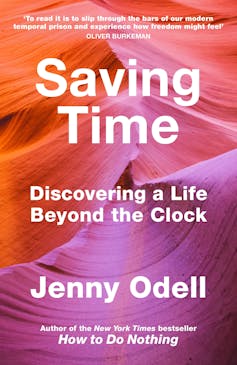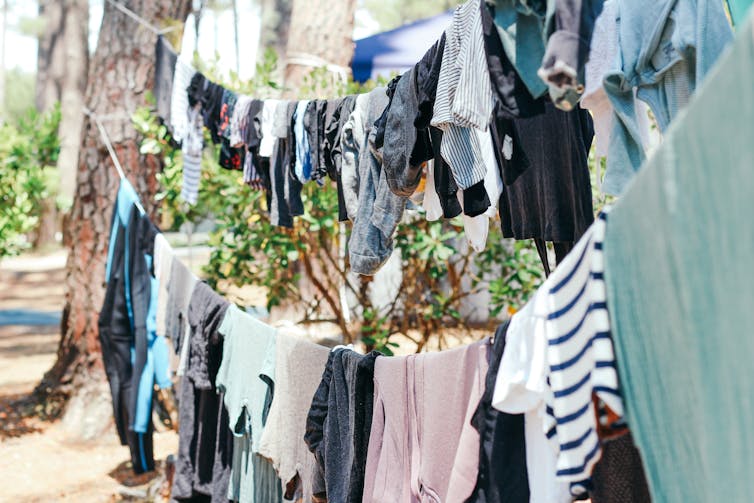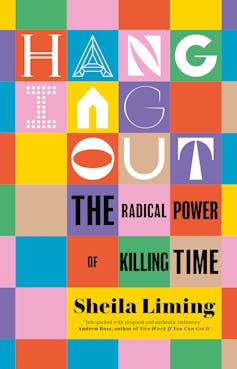When my daughter was in the early years of primary school, her class was asked what their parents’ hobbies were. My daughter piped up promptly with mine: ‘Reading, sleeping and drinking wine.’ This disclosure of my deficiencies – among the more well-adapted offerings of cycling, gardening, Pilates practice and marathon-running – got me in the soft nervous centre of my self-worth.
Sleeping, reading and drinking wine are three things I have always felt guilty about. They are emblematic of my chronic tendency to procrastinate, my lax self-regulation, my failure to use time productively. Excluding my contribution to the wine industry, they have no dollar value. They produce nothing of immediate, measurable value. They have no rounded sense of task completion at their end.
All of them require a loose and idle relationship with time. Reading US essayist Sheila Liming’s ‘Hanging Out: The radical power of killing time‘, I realise that, in indulging my dubious pastimes, I am in fact simply “hanging out” with myself.
And “hanging out” — that generous, time-lazy, day-squandering activity that seems to belong only to childhood and adolescence — may well be, Liming says, not only a “survival mechanism” and deeply human need, but an act of refusal, an act with a “radical character”.
Read: Good things happen when the young Dare to Dream
Reading Liming’s effortlessly intelligent book, I begin to more deeply understand where my guilt comes from. It’s not just coming from my liver. And I’m not sleeping 10 hours a day just to refresh myself for more productive work. I don’t read merely to become erudite and informed enough to pen articles like this.
I’m guilty because hanging out – either alone or with friends – has become anxiety-ridden, overthought, over-structured, over-laden. Unfree. All those other things I should be doing. And I can’t dismiss them, because they have colonised my very being.

Liming locates this colonisation — and by extension the guilt of the modern Western world — partly in the Protestant work ethic and the policing of self that equated idleness with the devil’s work. Idleness – always viewed suspiciously, especially if you were poor – became increasingly a moral sin that required vigilant resistance.
It’s a phenomenon Barbara Ehrenreich also wrote about in her 2010 critique of the US positive-thinking industry, Smile Or Die: How positive thinking fooled America and the world: a deep Calvinist contempt for the unimproved self that seeped into the bones and flesh of the US, holding the individual responsible for their misfortunes in the face of brutal systemic and structural inequity.
This ‘pull yourself up by your bootstraps’ culture (a phrase which, as Jenny Odell points out in Saving Time: Discovering a Life Beyond the Clock, is in itself oxymoronic) has metastasised into a full-body brutality driven relentlessly at the self: multi-directional, time insistent, waste-not want-not.
The strapping and tethering of time to the ends of free-market productivity rules out the conditions required for stretching and growing. We’ve known this, of course, since Marx’s Das Kapital (Capital) of 1867 – and we know it in our bodies on a daily basis, when we shed time like skin, until we are red and raw at the end of the day.
Here is where fun – where “hanging out” – becomes a powerful act of resistance. Fun is suspect because it hovers and refuses to land; it nets nothing and feeds the moment, not the bottom line.
‘Fun threatens to infect and pervert the sanctity of labour,’ writes Liming, ‘and also the power of those who would have us do more of it, for free, by cramming more into the slim, pre-existing spaces of pay cheques and contracts.’
Lassitude and playfulness, she writes, are necessary precursors to invention, imagination, connective social thought and behaviour. Sometimes a revelatory idea needs to come out of nowhere and not out of the focused training of the mind on a problem.
Commodified fun, of course, makes a profit for someone somewhere, and relies on the often poorly paid labour of someone somewhere. But fun that exists outside this space – whether it’s two bodies coming together, or 20, or 100, in a park or on a beach or in someone’s pebble-mix back garden – can be a powerful, soul-replenishing “No” to the warped logic of the world.

Childhood time and jamming
Was the actual texture of life, of human interaction, different in childhood: when time swam and wandered and then ebbed with the sun and the call to dinner?
Who is to say that the time I experience now – task-driven, minute-counting – is conceptually truer than that experienced by children? ‘When is it Christmas again?’ I remember asking my mother. She shook her head sadly: ‘Not for many months. Not till well after your birthday.’
How was it possible to wait through so much time? I imagined it like mud or treacle – a stretch of sticky, recalcitrant experience to be trudged through. I came to the compelling conclusion there must be a trick adults didn’t tell you about. That you just woke up one day to find you were old.

Songs come to mind. Pink Floyd, describing how you catch up with the sun, only to find it coming up behind you again. Ageing you every time.
Plays and literature come to mind: the purposeless waiting of Waiting for Godot, the real-time deterioration of Dorian Gray’s portrait, the backwards trajectory of Benjamin Button. Time ticks ineluctably down. Or is it a thing we must fill – a container, with deeds and experiences and successes – while we can? Or a thing to be escaped: the oldest bogeyman in the book.
Hanging out allows us to reconceptualise time. For me, Liming’s most potent example of differently experienced time was her chapter on jamming as a form of hanging out.
A group of musicians come together and, with trust and space, their creativities converge into a time-swelling conversation. It is a conversation that is ephemeral, tenuous, delicate sometimes, robust sometimes. And it comes from a place of attuned listening and connecting.
To improvise with other musicians involves the courage to magnanimously court error. It doesn’t capture time so much as fully inhabits it, in a dialogue in many parts and many voices. And because of its ephemerality, it eludes commodification. If the ‘record’ button is never hit, it exists in uncommodifiable space and time.
Reading Liming on jamming and improvisation, I was reminded of the title story of E Annie Proulx’s 1995 Heartsongs and Other Stories. In Heartsongs, we meet Snipe, a no-hoper conman, out for the next exploitable opportunity when he stumbles on the hokey mountaintop Twilight family.

He can’t quite work out the relationships between the family members, but at the end of a meal he is invited to, he is welcomed into their family musical circle. Hardly a word is uttered in this strange after-dinner ritual, but when the Twilights pick up their instruments and begin to play, Snipe becomes increasingly excited: propelled by the rhythms and strands and subtleties they create.
He sees at once that this is something beautiful and exquisite, precious and rare. Invaluable. But when he proposes to the Twilight family that he manage them, tour them – that there are unimaginable profits to be made – they are not only indifferent, but reject his proposition out of hand. Snipe slinks away, after various fruitless efforts to convince: he has no frame of reference for their refusal.
I kept coming back to Heartsongs while reading Hanging Out – in fact, it’s the only story I recall in Proulx’s collection. It is a lesson in humility, I think: stubborn, ethical humility that remains impervious to the marketing imperatives of the world. Improvisation, it tells us, can be a way of living. Time does not have to be turned into dollars.
“Politically subversive” sleep
My battle with excessive sleep, and the “waste of time” it represents has endured throughout my whole adult life. I have tried to curtail my sleeping, tried to sleep like others do (less), tried to stay awake in front of a computer screen when my eyes are rolling back in my head.
I have felt incessantly guilty about my need for sleep, and frightened when I read articles that tell me too much sleep will shorten my life. I have slept under desks in classrooms, on office floors, on couches in libraries and seats in parks. I have slept at a live music venue while the band played.
And I have slept at parties. Many, many parties. In my 20s, I threw large dinner parties where I’d spend the whole day cooking and preparing, and then, at 9pm, when the food was eaten, I’d go off to my bedroom and sleep. Having babies gave me the perfect excuse; I’d take them off to bed, breastfeed them and never resurface.
There must be others like me, I thought. I briefly entertained the notion of instigating a Sleep Club in Melbourne’s CBD, a place where people like me could go to safely sleep in between other activities. But how to ensure Sleep Club didn’t turn into Sex Club? How to pay for sheets and blankets and mattresses (and CBD rent)? And how to make Sleep Club profitable? Here was the very crux of the problem: how could I charge people to sleep? And wouldn’t that contradict the whole purpose of my idea?

In Saving Time, Jenny Odell tells us of activist and poet Tricia Hersey’s organisation Nap Ministry, established to address ‘the sleep deprivation of enslaved peoples and their status as commodifed bodies’. Nap Ministry encourages collective napping experiences, as well as performances and workshops geared to the reinstituting of sleep as a human right.
Hersey claims sleep as a politically subversive action (which helps me legitimise my own sleeping habits). But in Hanging Out, Sheila Liming writes of sleeping in a way that reveals to me what perhaps I was seeking in my own soporific social withdrawals.
Sleeping at parties, she writes, provides the ‘serenity of effortless inclusion’. It is safety made even safer by the murmur of social pleasure: a kind of umbrella or arc of exuberant warmth. This same hum of warmth and sociality and protection soothed me as a child when my parents’ dinner parties extended late into the night.
In this way, the pleasure of “hanging out” can be experienced vicariously. Liming cites Audre Lorde’s poem The Electric Slide Boogie, in which a dying woman listens to a party in full swing on the other side of her wall. There is no ‘Rage, rage against the dying of the light’ in her musings, but a soft, gentle and ultimately generous lament: ‘How hard it is to sleep/in the middle of life.’
Time and the extraction of labour
When did the productive use of time begin to be a measurement of human worth? Before the advent of modern clock-time, Jenny Odell tells us, the ‘tools of coordination’ – in Western Christendom at least – were bells, enforcing the ‘temporal discipline’ of Benedictine and Cistercian monks.
How gentle and undemanding bells seem to us in the 21st century – a languorous form of time-marking, which called us to prayer and food and sleep. Last year I was fortunate enough to spend a week in the tiny town of Sivignon in southern France: there I forgot about my watch all together, guided by half-hour chimes that didn’t even interrupt my sleep, though they continued unabated throughout the night.

In Saving Time, Odell locates the invention of fungible time – time that can be broken down into smaller and smaller measurable, productive increments – in the spreadsheets of Southern plantation owners.
Modern time, she suggests, came about as a product of slavery and its reduction of human worth to the extraction of labour. Reading this, it’s hard not to conclude humans are the inherent exploiters of other humans by any technology available or inventable – including the shared technology of time. Some of us have possessed time and, in the process, dispossessed others of it.
Centuries years later, we live in a world where time is even more minutely monitored. Workers may not clock in and out on the job anymore (old-fashioned punch cards at least marked a beginning and an end to a day’s work), but their time is as effectively surveilled by keystroke monitoring, key performance indicators and continuous improvement cycles – winnowing lives into smaller and smaller particles of data. Work bleeds into leisure and leisure bleeds into work; clear boundaries no longer exist.
Leisure itself has become merely another opportunity for self-optimisation (the above-mentioned marathons and Pilates). Slowness – initially a refutation of the obsessive equating of busyness with moral good – has been turned into its own form of consumption, and a form of consumption quarantined for the well-off. Slow-cooking, slow-living, “self-care” can’t be indulged by those frantically trying to make ends meet with a series of casual jobs in a gig economy. Time, writes Odell, has become ‘the punitive dimension’.
The “science of time”, most notably formalised in Frederick Winslow Taylor’s 1911 The Principles of Scientific Management, has given us a linear, task-oriented way of making sense of ourselves. Drawing on the work of German philosopher Josef Pieper, Odell argues leisure should be “vertical” not “horizontal”: ‘[T]rue leisure requires the kind of emptiness in which you remember the fact of your own aliveness.’
Many of us experienced this emptiness during COVID; we became “estranged from common forms of marking time” and thus more alive to time’s natural rhythms. We took long walks and noticed new buds on trees, watched fledgling falcons rouse from nests on the roofs of skyscrapers, heard the birdsong that had always existed behind the incessant industry and traffic of daily life.
In retrospect, COVID lockdown may seem merely a period of hiatus, from which the world has decisively returned. But there is political potential in the experience and the way it released us – briefly anyway – from our normal temporal subjugations.
Odell cites 19th century labour leader Ira Steward to make further sense of this experience. He described the experience of leisure as a ‘blank – a negative – a piece of white paper’, not something to be filled or pre-inscribed. Steward’s ‘blank’, writes Odell, ‘was less like foam padding keeping a hierarchy in place than like a gas [the] every increase [of which] carried the potential of more cracks in the system’.
In a world of temporal urgencies – of corporate and political greed; climate crisis; economic, race and gender inequality – we need these cracks. And we need the gas that creates them.
Women’s time “didn’t economically exist”
Central to any discussion of time is the way women have experienced the economic devaluation of their time. Arlie Russell Hochschild wrote in 1989 of the way feminism in effect created a “second shift” for women.
I’ve often thought of this as feminism’s gift to men, releasing them from the unilateral burden of bringing in a wage, but without repositioning them to take up their share of child-rearing and housework: in this brave new world, women simply did both forms of labour, paid and unpaid.
‘Where women are concerned,’ wrote Mariarosa Dalla Costa and Selma James, proponents of the 1970s Wages for Housework movement, ‘their labour appears to be a personal service outside of capital.’
Odell tells of the first New Zealand member of parliament Marilyn Wearing, who studied the provisioning for women’s time and unpaid labour in existing economic structures for her 1988 book If Women Counted: A New Feminist Economics. She found, quite simply, that women’s time, and women’s work, didn’t economically exist.

And if women’s work time doesn’t exist, what of women’s leisure time? In 1929, in A Room of One’s Own, Virginia Woolf asked:
[W]hat alternations of work and rest [might women] need, interpreting rest as not doing nothing but as doing something but something that is different; and what should that difference be? All this should be discussed and discovered.
As with so many of Woolf’s questions, the answers remain at large.
Were women in the past more wretchedly used by time? Or are the uses just different now: the burdens outsourced, displaced onto others so new burdens might be absorbed? I’ve often wondered, how – when they hardly had hot water and ran their clothes through a mangle after sloshing them in sudsy water with a paddle – women of the past managed so decisively to outdo us when it came to keeping the world clean?
I haven’t run an iron over an article of clothing in years. Boiling things, steaming things, soaking things, making vinegar and bicarb solutions, using lemon juice in remarkable ways to get out stains. Hard-bristled floor brushes on flagged floors, followed by mopping (with boiled water). How did they get all the grit out of the tiles and the baked on charcoal out of ovens? Did they use their time better than us?
In a certain part of Malaysia, Odell tells us, a woman’s measurement of time prevails; to the question “how long does it take to get there?” the answer may be “three-rice-cookings”. I like this remoulding of time in the shape of women’s traditional chores. How long does it take to get there? ‘Four nappy changes.’ ‘Six loads of washing.’ ‘Thirteen bedtime stories.’
Redefining time
Odell leads us from our small, narrow, self-flagellating experience of time to its deeper manifestations and inhabitations. She begins with moss: invisibly moving, formidably growing, in a way that is reminiscent of Sylvia Plath’s poem Mushrooms. In the creeping pathway of moss that grows in a cactus planter on her windowsill, Odell observes continuity at work, the feeding of time with more time: ‘Tomorrow was growing raw out of the husk of today.’
Plants, Odell writes, are ‘the ongoing materialisation of time itself’. And in rocks and stone and pebbles we bear witness to a geological time that is past, present and future all at once. We cannot suppress time or nature, or the nature–time confluence of events such as landslides. The subjecthood and agency of the non-human, of the apparently inert, teach us something that clocks cannot.

As do Indigenous notions of time. Bill Gammage’s 2012 book The Biggest Estate on Earth was revelatory upon publication not because of its carefully organised evidence of Indigenous plant cultivation, but because of the Indigenous conceptualisation of time the book conveyed.
Indigenous time was too vast to make fungible: it was understood across huge expanses of land, imagined well beyond the lifetime of the individual, connective of past, present and future. It was a conceptualisation of time so foreign to colonisers, the architects of fungible time, that it was ungraspable, only demeanable.
In measuring time so finely, in cutting it down and down into microscopic forms of accountability, we have demeaned time. We have made it sad and attenuated. We deny it its power and sanctity.
Modern time feels “poisonous”
Strangely, while reading Odell’s and Liming’s books, and thinking about this article, my wristwatch stopped working. It has remained on my arm regardless, stuck at an eternal 11:10, and I keep referring to it out of habit. I wish this were a source of calm for me, that it made me stop and think in ways other than minutes and hours. But it doesn’t. It makes me ill at ease, and reminds me of yet another thing to put on my to-do list (get battery).

I can’t find the ‘temporal latitude’ to disengage myself from the anxieties of a stopped watch, because I don’t live on a mountain or in a cave. I have a mortgage to pay and children to shepherd properly into adulthood. I don’t have the time to be loose, or big, about time. And this is the crux of so many of our current problems and neuroses. We know it. We know how modern time feels in our bodies – like quicksilver, poisonous, impossible to pin down.
Both Odell and Liming propose “time activism” as part of a larger project to address the urgent issues our world faces. We need a ‘strategic confiscation of time,’ Liming says: we need to kill time good and dead and let it resurface in its own natural, communal rhythms – informed by our needs and not our labour value.
But perhaps we also need to treat it more gently, to tend it with care and understanding. ‘Would it be possible,’ writes Odell, ‘not to save and spend time, but to garden it – by saving, inventing and stewarding different rhythms of life?’
Edwina Preston, PhD Candidate, The University of Melbourne
This article is republished from The Conversation under a Creative Commons licence. Read the original article.





